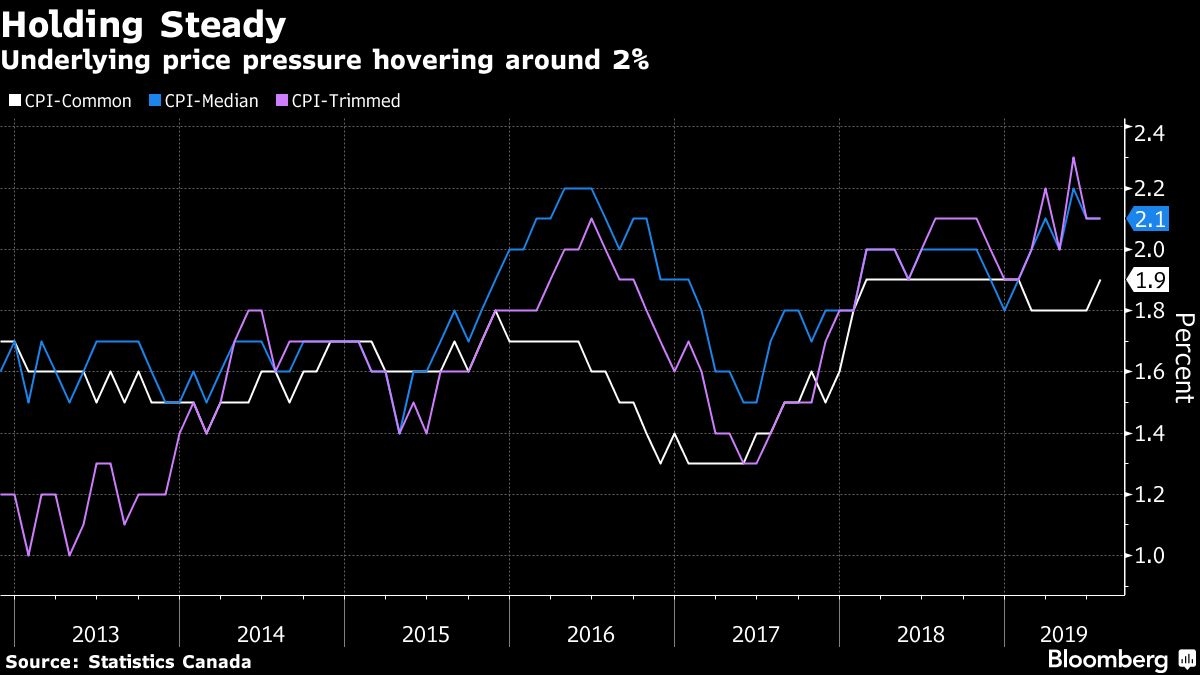Aug 21, 2019
Inflation holds steady at 2%, tempering case for rate cut
The Canadian Press
Bank of Canada 'caught between a rock and Trump' even as inflation hits target: Market strategist
Inflation in Canada was firmer than expected last month, keeping underlying price pressure right at the central bank’s target and giving policy makers one less reason to consider immediate interest rate cuts.
Annual consumer price inflation was two per cent in July, matching June’s pace, Statistics Canada said Wednesday from Ottawa. Economists had expected inflation to slow to 1.7 per cent. Core inflation, a better gauge of underlying pressure, unexpectedly ticked up slightly to 2.03 per cent.

Key Insights
- While sharp movements in gasoline prices have generated volatility in Canada’s headline inflation number, underlying price pressure has been remarkably stable near the Bank of Canada’s two per cent target for well over a year. This suggests a largely benign environment for inflation.
- Stronger inflation dynamics in Canada are one reason why economists and markets are anticipating fewer cuts, and a slower pace of reductions, by the Bank of Canada than the Federal Reserve. Markets are pricing in just one rate cut this year in Canada, even though some analysts have begun to speculate a cut could take place as early as the next rate decision in September due to growing global trade tensions.
- The expectation had been price gains would ease over the summer months, with the Bank of Canada projecting annual inflation to temporarily fall to 1.6 per cent in the third quarter before returning to 2 per cent. Wednesday’s numbers suggest inflation dynamics have been stronger than policy makers had predicted.
- Canada’s currency rose after the release, climbing 0.3 per cent to $1.3278 against its U.S. counterpart at 8:41 a.m. in Toronto. Two-year bond yields jumped 4 basis points to 1.39 per cent.
- “It’s an argument against a September rate cut, but they’ll still have to respond with stimulus if the global economy slows significantly,” Andrew Kelvin, senior Canada rates strategist at Toronto Dominion Bank.
Get More
- On a monthly basis, consumer prices rose 0.5 per cent, well above analyst projections for a 0.2 per cent gain.
- On a seasonally adjusted basis, prices rose 0.4 per cent, after a 0.1 per cent drop in June. Since February, monthly seasonally adjusted price inflation has averaged almost 0.3 per cent, double the monthly averages recorded in recent years.
- The average of three measures of core inflation tracked by the Bank of Canada rose slightly to 2.03 per cent in July, from a downwardly revised 2.0 per cent in June. The common rate was at 1.9 per cent, the median rate was 2.1 per cent and the trim rate was 2.1 per cent.
- Air transportation and travel tours was the biggest upward contributors to monthly CPI, along with gasoline and digital computing equipment and devices.
--With assistance from Erik Hertzberg.